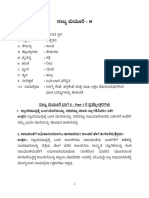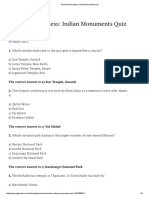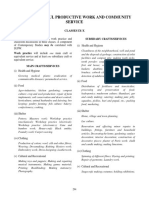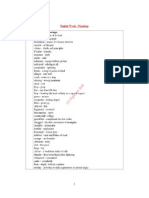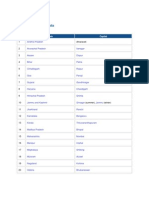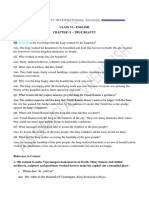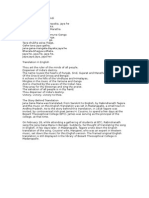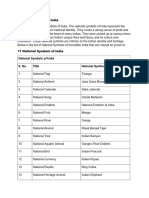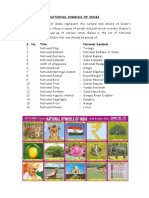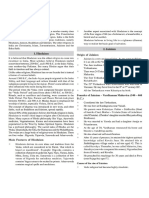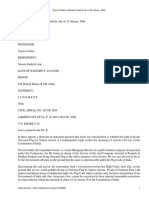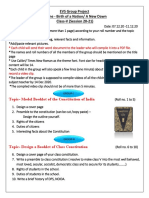0 ratings0% found this document useful (0 votes)
2K viewsNational Symbols of India
National Symbols of India
Uploaded by
MONIKA SHARMANational symbols of India include the tiranga flag, Jana Gana Mana anthem, Saka calendar, Vande Mataram song, state emblem depicting four lions, Indian rupee currency, Royal Bengal tiger, Indian peacock, Ganges river dolphin, mango fruit, lotus flower, banyan tree, Ganga river, king cobra, Indian elephant, and the national pledge. These symbols represent India's culture and history and instill national pride. There are 17 total national symbols that exemplify India's diversity and uniqueness.
Copyright:
© All Rights Reserved
Available Formats
Download as PDF, TXT or read online from Scribd
National Symbols of India
National Symbols of India
Uploaded by
MONIKA SHARMA0 ratings0% found this document useful (0 votes)
2K views7 pagesNational symbols of India include the tiranga flag, Jana Gana Mana anthem, Saka calendar, Vande Mataram song, state emblem depicting four lions, Indian rupee currency, Royal Bengal tiger, Indian peacock, Ganges river dolphin, mango fruit, lotus flower, banyan tree, Ganga river, king cobra, Indian elephant, and the national pledge. These symbols represent India's culture and history and instill national pride. There are 17 total national symbols that exemplify India's diversity and uniqueness.
Copyright
© © All Rights Reserved
Available Formats
PDF, TXT or read online from Scribd
Share this document
Did you find this document useful?
Is this content inappropriate?
National symbols of India include the tiranga flag, Jana Gana Mana anthem, Saka calendar, Vande Mataram song, state emblem depicting four lions, Indian rupee currency, Royal Bengal tiger, Indian peacock, Ganges river dolphin, mango fruit, lotus flower, banyan tree, Ganga river, king cobra, Indian elephant, and the national pledge. These symbols represent India's culture and history and instill national pride. There are 17 total national symbols that exemplify India's diversity and uniqueness.
Copyright:
© All Rights Reserved
Available Formats
Download as PDF, TXT or read online from Scribd
Download as pdf or txt
0 ratings0% found this document useful (0 votes)
2K views7 pagesNational Symbols of India
National Symbols of India
Uploaded by
MONIKA SHARMANational symbols of India include the tiranga flag, Jana Gana Mana anthem, Saka calendar, Vande Mataram song, state emblem depicting four lions, Indian rupee currency, Royal Bengal tiger, Indian peacock, Ganges river dolphin, mango fruit, lotus flower, banyan tree, Ganga river, king cobra, Indian elephant, and the national pledge. These symbols represent India's culture and history and instill national pride. There are 17 total national symbols that exemplify India's diversity and uniqueness.
Copyright:
© All Rights Reserved
Available Formats
Download as PDF, TXT or read online from Scribd
Download as pdf or txt
You are on page 1of 7
SUBJECT- GENERAL KNOWLEDGE
NATIONAL SYMBOLS OF INDIA
National Symbols of India
Here is the list of national symbols of India.
Title National Symbols
National Flag Tiranga
National Anthem Jana Gana Mana
National Calendar Saka calendar
National Song Vande Mataram
National Emblem National Emblem of India
National Fruit Mango
National River Ganga
National Animal Royal Bengal Tiger
National Tree Indian Banyan
National Aquatic Animal Ganges River Dolphin
National Bird Indian Peacock
National Currency Indian Rupee
National Reptile King Cobra
National Heritage Animal Indian Elephant
National Flower Lotus
National Vegetable Pumpkin
Oath of Allegiance National Pledge
Importance of National Symbols of India
There are 17 national symbols of India. The Importance of National Symbols is given
below.
1. They exemplify the rich cultural fiber that resides at the core of the country.
2. Infuse a deep sense of pride in the hearts of Indian citizens.
3. Represent a quality unique to India and its citizens.
4. Popularize the object chosen.
5. Help to preserve the chosen national symbol for generations to come.
Here is the detailed information about the national symbols of India.
National Flag: Tiranga
Tiranga is the national flag of India. The flag is designed by Pingali Venkayya and was
adopted by the Constituent Assembly on 22nd July 1947.
The top saffron colour, indicates the strength and courage of the country. The white
middle band indicates peace and truth with Dharma Chakra. The green colour shows
the fertility, growth and auspiciousness of the land. Its design is that of the wheel
which appears on the abacus of the Sarnath Lion Capital of Ashoka. Its diameter
approximates to the width of the white band and it has 24 spokes. The design of the
National Flag was adopted by the Constituent Assembly of India on 22 July 1947.
National Emblem: State Emblem of India
The national emblem of India is adopted from Lion Capital of Ashoka at Sarnath. Its
motto is Satyameva Jayate; ("Truth Alone Triumphs). It features four Asiatic lions
standing back to back, mounted on an abacus with a frieze carrying sculptures in high
relief of an elephant, a galloping horse, a bull and a lion separated by intervening
wheels over a bell-shaped lotus. The National Emblem symbolizes power, courage,
confidence and at the bottom is a horse and a bull with beautiful wheel Dharma chakra
at centre.
National Calendar: Saka Calendar
Saka Calendar was introduced by the Calendar Committee in 1957. The usage of the
Saka Calendar was officially started at 1 Chaitra 1879 Saka Era, or 22 March 1957.
National Anthem: Jana Gana Mana
The National Anthem of India Jana-gana-mana, composed originally in Bengali
by Rabindranath Tagore, was adopted in its Hindi version by the Constituent
Assembly as the National Anthem of India on 24 January 1950. It was first sung on 27
December 1911 at the then Calcutta Session of the Indian National Congress.
The complete song consists of five stanzas. The first stanza contains the full version of
the National Anthem.
National Song: Vande Matram
The song of India is Vande Mataram, composed in Sanskrit by Bankimchandra
Chatterji. On January 24, 1950, the President, Dr. Rajendra Prasad came up with a
statement in the Constituent Assembly, "the song Vande Mataram, which has played
a historic part in the struggle for Indian freedom, shall be honoured equally with Jana
Gana Mana and shall have equal status with it."
The first political occasion when Vande Matram was sung was the 1896 session of the
Indian National Congress. The song was a part of Bankimchandra's most famous novel
Anand Math (1882).
National Currency: Indian Rupee
The Indian rupee (ISO code: INR) is the official currency of the Republic of India. The
issuance of the currency is controlled by the Reserve Bank of India. The Indian rupee
symbol is derived from the Devanagari consonant "र" (ra) and the Latin letter "R" was
adopted in 2010. It has been designed by Udaya Kumar Dharmalingam. The INR
depicts an equality sign that symbolizes the nation's desire to reduce economic
disparity. The design of the INR was selected from among five shortlisted symbols.
According to Udaya Kumar the design is based on the Indian tricolour.
National Animal: Bengal Tiger
Royal Bengal Tiger is the national animal of India and ranks among the biggest cats
in the world. It was adopted as the national animal of India in April 1973 due to the
dwindling population of the tigers. Prior to the tiger the national animal of India was
the Lion.
National Bird: Peacock
The Indian peacock (Pavo cristatus) is the national bird of India. A bird indigenous to
the subcontinent, the peacock represents the unity of vivid colours and finds
references in Indian culture. The Government of India declared the Peacock as the
national bird of India on February 1, 1963. It is found in the drier lowland areas and a
resident breeder across the Indian subcontinent.
National Aquatic Animal: Dolphin
The Ganges river dolphin has been declared as National Aquatic Animal of India by the
Indian government. It is also the city animal of the Guwahati. The South Asian river
dolphin primarily found in the Ganges, Yamuna, Chambal river, Brahmaputra river and
their tributaries.
National Fruit: Mango
Mango (Mangifera indica) , affectionately called King of Fruits is the National fruit of
India. Its sweet fragrance and delectable flavors have won the hearts of many around
the world since time immemorial. As the national fruit of India it represents
prosperity, abundance and richness in favor of the country’s image.
National Flower: Lotus
The national flower of India is Lotus (Nelumbo nucifera). It is an aquatic herb that is
often termed as ‘Padma’ in Sanskrit and enjoys a sacred status among the Indian
culture. The Lotus symbolizes spirituality, fruitfulness, wealth, knowledge,
illumination, along with purity of heart and mind.
National Tree: Banyan Tree
The national tree of India is the Banyan tree, designated formally as Ficus
benghalensis. The tree is often symbol of the fabled ‘Kalpa Vriksha’ or the ‘Tree of Wish
Fullfillment’ as it is associated with longevity and has important medicinal properties.
The very size and life span of the banyan tree makes it a habitat for a large number of
creatures.
National River: Ganga
The Ganges or the Ganga is the national river of India. It originates in the snowfields
of the Gangotri Glacier in the Himalayas as the Bhagirathi River. According to the
Hindus, this is the most sacred river on the earth. Interestingly, the Ganga is also the
longest river in India covering 2,510 km of mountains, plains and valleys. The major
Indian cities through which it passes through are Varanasi, Allahabad and Haridwar.
National Reptile: King Cobra
King Cobra or Snake eater (Ophiophagus hannah) is the National Reptile of India and
is found in the forests of India and Southeast Asia. It is the world longest venomous
snake which is capable of growing up to 19 ft and may live up to 25 years.They have
an ability to inject 6 ml of venom in a single bite. It has its own cultural significance, in
Hinduism King cobra is also known as Nagas and are considered as divine and
worshiped Lord Shiva is often depicted with a cobra coiled around his neck.
National Heritage Animal: Indian Elephant
The Indian Elephant has been declared as National Heritage animal of India,native to
mainland Asia. The Indian elephant has been listed as endangered and threatened by
habitat loss, fragmentation and degradation.
Oath of Allegiance: National Pledge
The National Pledge is an oath of allegiance to the Republic Of India. It is commonly
recited by Indians in unison at public events, especially in schools, and during the
Independence Day and Republic Day celebrations. The pledge was originally
composed in Telugu language by writer Pydimarri Venkata Subba Rao in 1962. It was
first read out in a school in Visakhapatnam in 1963 and was subsequently translated
into various regional languages.
You might also like
- Siddhartha BasuDocument45 pagesSiddhartha Basumohan mp33% (3)
- Bengali Grammar Book PDFDocument93 pagesBengali Grammar Book PDFSrimanta AdakNo ratings yet
- National Symbols of IndiaDocument4 pagesNational Symbols of Indiasunil78No ratings yet
- General KnowledgeDocument4 pagesGeneral KnowledgeSanthosh AbinavNo ratings yet
- Our National Symbols 1624209560Document5 pagesOur National Symbols 1624209560shreyasNo ratings yet
- English Lang PDFDocument4 pagesEnglish Lang PDFTanay50% (2)
- Chapter 5 - Natya Mayuri - NotesDocument5 pagesChapter 5 - Natya Mayuri - Notestanya.bhoopalamNo ratings yet
- General Awareness Indian Monuments QuizDocument3 pagesGeneral Awareness Indian Monuments QuizVivek Jain100% (2)
- Maths Project 1Document5 pagesMaths Project 1Abhi KrickNo ratings yet
- ICSE and ISC Project FormatDocument13 pagesICSE and ISC Project Format7141No ratings yet
- Computer Project Class X-By Me ICSE 2023-24, Hotel ManagementDocument20 pagesComputer Project Class X-By Me ICSE 2023-24, Hotel ManagementsubarnadmrNo ratings yet
- An Autobiography of A RiverDocument6 pagesAn Autobiography of A Riverbhubanobc2007No ratings yet
- GK PaperDocument3 pagesGK Papertanujagoyal107No ratings yet
- Aecs Class 5 Practice Test Term1evs17Document13 pagesAecs Class 5 Practice Test Term1evs17spanja_barcNo ratings yet
- Guidelines For Grade X Math Project 2023-2024Document6 pagesGuidelines For Grade X Math Project 2023-2024shubh laddhaNo ratings yet
- 20 GK Questions On National Symbols - BlankDocument5 pages20 GK Questions On National Symbols - BlankAnil KumarNo ratings yet
- Sharing ResponsibilityDocument7 pagesSharing Responsibilitybalu56kvNo ratings yet
- Problems With Tourism in IndiaDocument2 pagesProblems With Tourism in IndiaPankaj SharmaNo ratings yet
- ICSE SUPW and Community ServiceDocument7 pagesICSE SUPW and Community ServiceGokul RahulNo ratings yet
- 1st Class Holiday HomeworkDocument2 pages1st Class Holiday HomeworkGouravNo ratings yet
- 10 ICSE APC Computer Applications Chapter 2 Library Classes UNSOLVED PROGRAMS SOLUTIONSDocument18 pages10 ICSE APC Computer Applications Chapter 2 Library Classes UNSOLVED PROGRAMS SOLUTIONSRajat BhattiNo ratings yet
- Know and Grow 5 Answer Single Color - CroppedDocument12 pagesKnow and Grow 5 Answer Single Color - CroppedSaheb Biswas0% (1)
- Class5 Evs Whose ForestDocument6 pagesClass5 Evs Whose Forestlalitarani_05No ratings yet
- TNPSC Group I and Group II General English and Grammar NotesDocument42 pagesTNPSC Group I and Group II General English and Grammar NotesMano Ranjani0% (1)
- ClassIV Ame O Ama Paribesa PDFDocument208 pagesClassIV Ame O Ama Paribesa PDFjohn4jNo ratings yet
- Class 6 Holiday HomeworkDocument8 pagesClass 6 Holiday HomeworkBackup AryNo ratings yet
- GK QuestionsDocument5 pagesGK QuestionsAnkita RathoreNo ratings yet
- Class 4 MathematicsDocument35 pagesClass 4 MathematicsnngowriharibaskarNo ratings yet
- GardnerrDocument4 pagesGardnerrDiva VNo ratings yet
- Computation of Whole NumbersDocument3 pagesComputation of Whole NumbersFun and FitnessNo ratings yet
- Financial Literacy Notes Sem IDocument34 pagesFinancial Literacy Notes Sem Ihayabusak137No ratings yet
- Chapter - 1 India-Relief Features: Fill in The BlanksDocument3 pagesChapter - 1 India-Relief Features: Fill in The BlanksSudhakarNo ratings yet
- GR 4 Chapter 10 Our Government Notebook WorkDocument5 pagesGR 4 Chapter 10 Our Government Notebook Workanil gupta100% (1)
- CLASS-10: Banking (Recurring Deposit)Document9 pagesCLASS-10: Banking (Recurring Deposit)Manju Yadav100% (1)
- Important Committees On Banking in IndiaDocument4 pagesImportant Committees On Banking in IndiaSachin SahooNo ratings yet
- Pà Àßqà Àtð Àiá Éaiàä Àäß Àçtðuéæ J: (Complete The Kannada VarnamaleDocument8 pagesPà Àßqà Àtð Àiá Éaiàä Àäß Àçtðuéæ J: (Complete The Kannada VarnamaleTanay Venu100% (1)
- History: Develop An Illustrative Study of The Contributions of U.N.O. and It's Agencies - WHO, UNICHEF, UNESCODocument26 pagesHistory: Develop An Illustrative Study of The Contributions of U.N.O. and It's Agencies - WHO, UNICHEF, UNESCOAlfiya Khan0% (1)
- GK 4 Art and Culture (Music, Classical and Folk Dance)Document29 pagesGK 4 Art and Culture (Music, Classical and Folk Dance)himakartikeya2468No ratings yet
- PoastersDocument4 pagesPoastersAnshumanmodiNo ratings yet
- Sindhudurg FortDocument3 pagesSindhudurg FortTimothy BrownNo ratings yet
- States and Capitals of IndiaDocument2 pagesStates and Capitals of IndiaPoorviStr80% (5)
- Math Final Project On BudgetDocument13 pagesMath Final Project On BudgetMeenakshi Yadav33% (3)
- CH 11 True Beauty MLPDocument2 pagesCH 11 True Beauty MLPNaitik Bansal100% (1)
- Self-Help To New Gems English Reader 7Document28 pagesSelf-Help To New Gems English Reader 7rajib saha0% (1)
- Holiday Assignment Class 9 - SOCIAL SCIENCEDocument6 pagesHoliday Assignment Class 9 - SOCIAL SCIENCEMaaz UddinNo ratings yet
- Important days-PSC-GK QuestionDocument14 pagesImportant days-PSC-GK QuestionSarinPaluvallyNo ratings yet
- GK Current AffairsDocument3 pagesGK Current AffairsDeepak SinghNo ratings yet
- Waste Management Frank Brothers Class 10 IcseDocument12 pagesWaste Management Frank Brothers Class 10 IcsearanyaadasNo ratings yet
- Class 6 Maths Dav 22 23Document6 pagesClass 6 Maths Dav 22 23Ràunak Kumar100% (2)
- Aarambh LyricsDocument2 pagesAarambh LyricssuryanshNo ratings yet
- National Anthem English TranslationDocument1 pageNational Anthem English TranslationNagina ChawlaNo ratings yet
- A Hero QuizDocument3 pagesA Hero QuizPurusottam BeraNo ratings yet
- ICSE Sylb Class 3Document3 pagesICSE Sylb Class 3deepaNo ratings yet
- NCERT Class 6 Hindi Vasant Chapter 3 Nadaan Dost PDFDocument10 pagesNCERT Class 6 Hindi Vasant Chapter 3 Nadaan Dost PDFAbhigya67% (3)
- General KnowledgeDocument34 pagesGeneral KnowledgeOishee RoyNo ratings yet
- Rajasthan Genral KnowledgeDocument14 pagesRajasthan Genral KnowledgeHarish Kumar MahavarNo ratings yet
- GK Questions For Class 10Document7 pagesGK Questions For Class 10a.nangelorganiserNo ratings yet
- National Symbols of India S. No. Title National SymbolsDocument9 pagesNational Symbols of India S. No. Title National SymbolsfarzanareshuNo ratings yet
- Symbols NationalDocument5 pagesSymbols Nationalnageshwara chariNo ratings yet
- Symbols of IndiaDocument20 pagesSymbols of Indiatanishka.babbar111No ratings yet
- Mahajan A PadasDocument10 pagesMahajan A PadasMONIKA SHARMANo ratings yet
- Religion of IndiaDocument4 pagesReligion of IndiaMONIKA SHARMANo ratings yet
- Vice - President of IndiaDocument2 pagesVice - President of IndiaMONIKA SHARMANo ratings yet
- Vice PresidentDocument7 pagesVice PresidentMONIKA SHARMANo ratings yet
- IMO Class 5 Sample Papers 2022 23Document3 pagesIMO Class 5 Sample Papers 2022 23MONIKA SHARMA100% (1)
- Office Procedure Manual Updated 061e6685a7dfff8 36905466Document150 pagesOffice Procedure Manual Updated 061e6685a7dfff8 36905466yoursosweet666No ratings yet
- Indian Flag QuizDocument3 pagesIndian Flag QuizRita UpadhyayNo ratings yet
- LESSON 14 My CountryDocument7 pagesLESSON 14 My CountryPriyanka ShrivastavaNo ratings yet
- STD 9 TH English Bridge CourseDocument50 pagesSTD 9 TH English Bridge CoursePal Ram100% (1)
- Final 25th January Republic DayDocument30 pagesFinal 25th January Republic DayThe PhantomNo ratings yet
- Essay On Independence DayDocument3 pagesEssay On Independence DayShabaaz ShaikhNo ratings yet
- 3ef8dthe National FlagDocument25 pages3ef8dthe National Flaggaurarpit24100% (1)
- Nationaism in IndiaDocument8 pagesNationaism in Indiarishabjain182736No ratings yet
- August or 2016Document137 pagesAugust or 2016tudujiban12No ratings yet
- Union of India Vs Naveen Jindal & Anr On 23 January, 2004Document20 pagesUnion of India Vs Naveen Jindal & Anr On 23 January, 2004pshubham65_5517202270% (1)
- Std. III Ch.8 National Symbols and Emblem WS-2Document2 pagesStd. III Ch.8 National Symbols and Emblem WS-2Pinky PatelNo ratings yet
- Independence Day Quiz - Kids PDFDocument2 pagesIndependence Day Quiz - Kids PDFcallchandru50% (2)
- Learn CBSE: Social Science Class 10 Important Questions History Chapter 3 Nationalism in IndiaDocument30 pagesLearn CBSE: Social Science Class 10 Important Questions History Chapter 3 Nationalism in IndiaAnalytical Fincon Pvt. Ltd.No ratings yet
- Raus India Year Book 2016Document146 pagesRaus India Year Book 2016Ashwin GowdaNo ratings yet
- Legal Internship Program 2022 Case StudyDocument7 pagesLegal Internship Program 2022 Case StudyIla SinghNo ratings yet
- Tiranga Colour Game - Celebrating The Spirit of India Through PlayDocument4 pagesTiranga Colour Game - Celebrating The Spirit of India Through Playrs3471055No ratings yet
- Indian FlagDocument5 pagesIndian Flagmanasvivaid0304No ratings yet
- Significance of National SymbolsDocument4 pagesSignificance of National SymbolsDisha BathamNo ratings yet
- The Evolution of Indian National FlagDocument3 pagesThe Evolution of Indian National FlagKhushi TyagiNo ratings yet
- EVS Group Project Class-VDocument3 pagesEVS Group Project Class-VNaitik SinghNo ratings yet
- Indian Flag Colors Meaning - Google SearchDocument1 pageIndian Flag Colors Meaning - Google SearchBalavinayakNo ratings yet
- Aejm 101Document9 pagesAejm 101thakurpiyushkumarNo ratings yet
- National Flag of IndiaDocument2 pagesNational Flag of IndiaJuan Diego Moncaleano LópezNo ratings yet
- A Text Book of Fine ArtsDocument41 pagesA Text Book of Fine Artskushalx1316No ratings yet
- PAINTINGDocument33 pagesPAINTINGRudhra SharmaNo ratings yet
- UntitledDocument4 pagesUntitledapi-233604231No ratings yet
- Pingali Script FinalDocument22 pagesPingali Script FinalTrisha BiswasNo ratings yet
- Har Ghar Tiranga Letter & Guideline - 024253Document15 pagesHar Ghar Tiranga Letter & Guideline - 024253Shahruk AhmedNo ratings yet
- Toddler 1 GK Qestions With AnswersDocument2 pagesToddler 1 GK Qestions With AnswersbagathmNo ratings yet
- Hans Bengaluru 30-01-2024Document12 pagesHans Bengaluru 30-01-2024newspapermaekNo ratings yet






